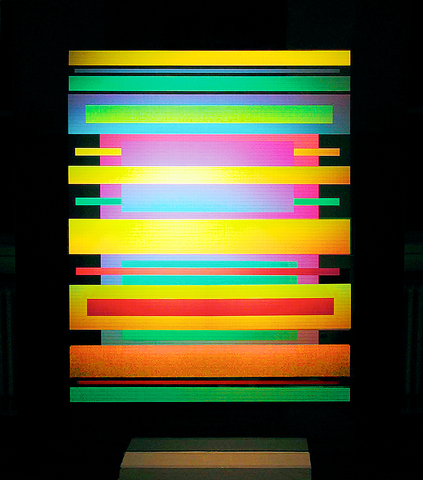The aptly named exhibition The Garden of Light features the sparkling light and luminescent color that emanates from the holographic art, paintings, prints, mobiles and installations of German artist Dieter Jung.
On view at the Taipei Fine Arts Museum until May 8, with a smaller complementary display of prints at the German Cultural Center, the exhibition will then travel to the Kaohsiung Museum of Fine Arts.
In the Taipei Fine Arts Museum's lobby, the Calder-like mobile of silvery convex mirrors titled Transoptics slowly moves reflecting images of passersby upside-down. It is a good introductory piece to prepare the viewer for the show where the the work on view is about optical effects, visual perception, and how light hits on reflected surfaces.

PHOTOS COURTESY OF THE TAIPEI FINE ARTS MUSEUM
Jung's exhibition in Taiwan starts with the story of the Chinese magic mirror. Created over 2,000 years ago in China, a shiny bronze disk was made so that an image of the relief on its underside could be projected onto a screen by shining a light on it. The technology behind it predates holography as the same principle of manipulating light-waves.
The obsoleteness of the mirror serves as a lesson that advanced technology will not go beyond novelty without a good concept behind it. So, it is that combination of scientific technology and aesthetic conception that motivates the artist, who also displays his own magic mirror.
Trained in theology before becoming an artist, Jung's background in philosophical investigations of existence and belief clearly informs his art. Though the works are secular, many of the non-narrative pieces would fit into any temple or house of worship as the works have an ethereal quality.

Perhaps the absence of both a narrative and a figure allows the viewer to read any kind of meaning into a simple geometric shape.
When Jung's works were shown at the Hara Museum in Tokyo, visitors sat down in front of them to meditate, as the works do have that unearthly aura about them.
So Jung was quite pleased when one of the Taipei museum guards said that in the holograms he could see eternity.

Perhaps the guard was referring to the Parochial RGB series of brightly hued geometric shapes on flat rectangular pieces of mirrored glass installed on plinths. From a distance, the holograms burst with intense, glowing color.
In holography, three-dimensional images are created on a flat surface through the diffraction of light waves with a laser. Many popular holographs contain representational images such as people, animals and buildings. In Jung's work, however, he shows that profound thoughts can be stated abstractly with only a simple line or shape.
The human figure is mainly absent from the work, with the exception of Self Portrait with Prism, where the artist is portrayed in the realm of his special technique. And a series of large white-on-white acrylic paintings bear the portraits of famous men such as Sigmund Freud and Ezra Pound. Since the contrast of the colors is slight, the images can only be seen from a distance.
It is the constant negotiating of the space around the work that the viewer must confront. So, whether the works are paintings with low-value contrast or the iridescent holographic panels, the viewer becomes a dance partner to the work, taking a step forward and back, tilting the head sideways until the right combination of distance and light are achieved to see the work in all its shimmering luminosity.
The third floor of the museum has always been a problematic space to exhibit, as the area encircles the bank of escalators and feels more like a foyer than an intimate viewing area. So a small alcove was created for the work Lines of Flight.
A large window was cut into the wall that contains a moving floor-to-ceiling holograph of vertical lines in primary colors that give the appearance of monolithic skyscrapers.
Jung exhibits a more literary and figurative type of work at the German Cultural Center in LightColourSpace.
A popular series of posters he made for a publisher of philosophy books in the 1970s includes portraits of thinkers such as Goethe, Kant, Einstein and Schiller superimposed with an intricate netting of woven lines.
And the pivotal piece on display is a small holograph of Goethe -- who developed his own color theory -- wryly perched on a stack of the famous writer's books.
This smaller exhibition about appearance and disappearance also provides a good opportunity to learn more about the center's facilities and to contemplate the juncture between art and science.
Event Information:
What: The Garden of Light
Where: The Taipei Fine Arts Museum, 181 Zhongshan N Rd, Sec 3, Taipei (
When: Until May 8, Tuesday to Sunday, 9:30am to 5:30pm
Tel: (02) 2595 7656
Information: http://www.tfam.gov.tw
What: LightColourSpace
Where: The German Cultural Center, 12F, 20 Heping W Rd, Sec 1 (
When: Until April 15, Monday to Friday, 10am to 8pm
Tel: 2365-7294
Information: http://www.dk-taipei.org.tw

This month the government ordered a one-year block of Xiaohongshu (小紅書) or Rednote, a Chinese social media platform with more than 3 million users in Taiwan. The government pointed to widespread fraud activity on the platform, along with cybersecurity failures. Officials said that they had reached out to the company and asked it to change. However, they received no response. The pro-China parties, the Chinese Nationalist Party (KMT) and Taiwan People’s Party (TPP), immediately swung into action, denouncing the ban as an attack on free speech. This “free speech” claim was then echoed by the People’s Republic of China (PRC),

Exceptions to the rule are sometimes revealing. For a brief few years, there was an emerging ideological split between the Democratic Progressive Party (DPP) and Chinese Nationalist Party (KMT) that appeared to be pushing the DPP in a direction that would be considered more liberal, and the KMT more conservative. In the previous column, “The KMT-DPP’s bureaucrat-led developmental state” (Dec. 11, page 12), we examined how Taiwan’s democratic system developed, and how both the two main parties largely accepted a similar consensus on how Taiwan should be run domestically and did not split along the left-right lines more familiar in

Specialty sandwiches loaded with the contents of an entire charcuterie board, overflowing with sauces, creams and all manner of creative add-ons, is perhaps one of the biggest global food trends of this year. From London to New York, lines form down the block for mortadella, burrata, pistachio and more stuffed between slices of fresh sourdough, rye or focaccia. To try the trend in Taipei, Munchies Mafia is for sure the spot — could this be the best sandwich in town? Carlos from Spain and Sergio from Mexico opened this spot just seven months ago. The two met working in the

Many people in Taiwan first learned about universal basic income (UBI) — the idea that the government should provide regular, no-strings-attached payments to each citizen — in 2019. While seeking the Democratic nomination for the 2020 US presidential election, Andrew Yang, a politician of Taiwanese descent, said that, if elected, he’d institute a UBI of US$1,000 per month to “get the economic boot off of people’s throats, allowing them to lift their heads up, breathe, and get excited for the future.” His campaign petered out, but the concept of UBI hasn’t gone away. Throughout the industrialized world, there are fears that